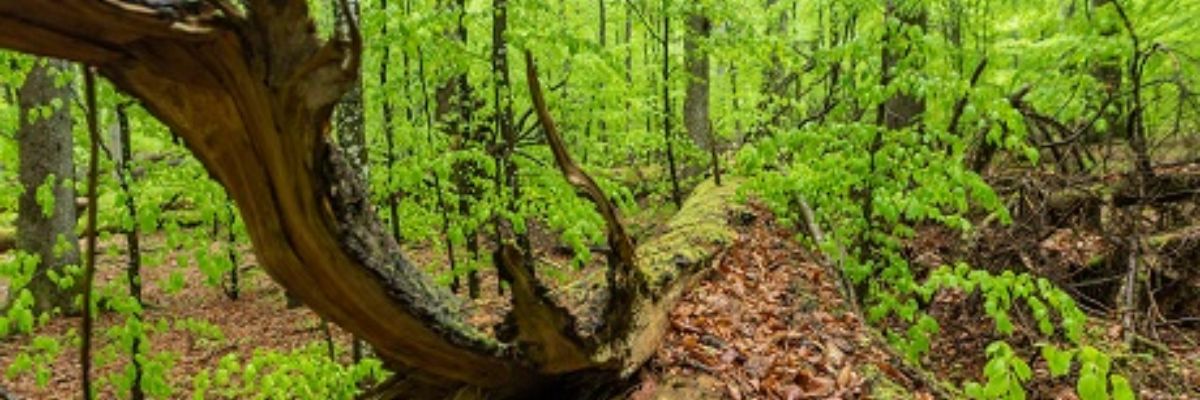
Žofín Forest: an outdoor research lab
03. 08. 2022
It is the most thoroughly examined forest in the Czech Republic. The Žofín Primeval Forest in the Novohradské hory (Gratzen Mountains) is one of the few forests that has resisted human intervention, sawmills, and chainsaws. Here, nature has reigned supreme for almost 200 years, allowing researchers a glimpse into a unique world. Thousands of trees, among other flora, are being monitored by experts here. What has the forest ecosystem revealed to CAS researchers, and what are they currently working on?
Botanist Přemysl Bobek sticks a handheld soil probe into the ground, gives it a few turns, and pulls it back out. The hollow groove is about 60 centimetres long and now full of peat. “Here we’ve dug up seven thousand years of history,” the researcher from the Institute of Botany of the CAS points to the deepest peat he has pulled out of the ground. I hold up a centimetre-long clump of needles from the scooped-out sediment. “Is this really seven thousand years old?” I ask incredulously. “It is,” the botanist replies with a smile. In recent years, he has worked in the forest with colleagues from The Silva Tarouca Research Institute for Landscape and Ornamental Gardening. Their aim was to reconstruct the historical development and species composition of the forest, which in the distant past looked very different from what it is today.
The 102-hectare Žofín Primeval Forest is one of the oldest protected areas in Central Europe. The peat bog is in the very heart of it. Windfall surrounds it – i.e., uprooted tree roots with an abundance of soil material. They reach up to two metres in height (diameter). The dead trees and broken branches stuck in the ground were left here by the devastating Cyclone Kyrill, which swept through the area in January 2007. A year later, the area was hit by Cyclone Emma. After the devastation, the debris in the area wasn’t cleared away, and so the felled trunks of the once giant trees were left as they were, as dictated by the practice in primeval forests.
Today, new green life is slowly proliferating across the rotting wood – moss, lichen, and spruce saplings, claiming their place in the sun. The forest is also home to a small solar power plant that serves researchers and – in a place without coverage or roads – brings one back to the 21st century.
Fire history
I try to keep my balance on tiny islands of solid ground within the peat bog. It’s quite shallow, but one misstep and I could sink to a depth of just over one metre – a depth where nature has preserved up to seven-and-a-half-thousand years of history in the sediment. Researchers have been learning about the evolution of the forest by analysing pollen grains. But they haven’t limited themselves to this alone. To get a more complete picture of what the local forest looked like in the past, they’ve also been searching for answers in charcoal – the charred parts of plants and trees that have appeared as a result of forest fires. At various spots within the forest, experts dug eight probes to a depth of about one-and-a-half metres below the surface, covering most of the forest.
“Not only do the organisms themselves, the trees, play an important role in the development of the forest, but also disturbances, i.e., disruptions of the ecosystem, comprise a significant factor. These can take the form of, for instance, heavy logging, human interference, large-scale mortality caused by bark beetles, and fires,” Přemysl Bobek explains, as he sticks a small knife into the soil which has been brought to the surface by a two-metre-wide uprooted tree, and immediately points to a barely perceptible fragment of charcoal soil. “I’ve seen tens of thousands of them – I have an eye for it by now.”
Silent witnesses of ancient times
Charcoal is very durable. While subject to fragmentation, crumbling into smaller and smaller pieces, microorganisms cannot break it down completely. Thanks to charcoal soil, researchers have been able to go a bit further than the analysis of pollen grains offers. They looked back almost to the end of the Ice Age, i.e., 11,700 years ago. “We were interested in how frequently fires occurred in the past and how they affected the forest during its millennia-long evolution,” the botanist adds.
Researchers were also able to read ancient history from the charcoal thanks to radiocarbon dating, which allowed them to determine the exact age of the charred plant material. It revealed that 11,000 years ago, the dominant tree species was pine. In what is now the primeval forest, there were probably sparse pine forests which spread as the climate warmed to areas originally covered by mountain tundra. The mere presence of the charcoal also testifies to the occurrence of large-scale fires, which at that time would flare up about once every 250 years. It took another six thousand years for today’s dominant European beech and silver fir to gradually find their way here and begin to grow in large numbers. Researchers date the origin of the present forest type to approximately six thousand years ago.
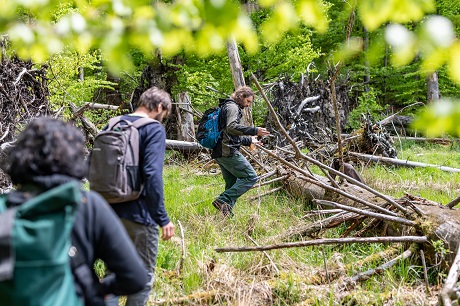
Moving around in the forest is difficult. Fallen trees are everywhere, and you’re always at risk of sinking into the peat bogs.
According to archival records, people have inhabited the foothills of the Novohradské hory since medieval colonisation times, and analysis of pollen grains and microscopic charcoal has revealed that they implemented controlled burns of the forest to then grow grain in the resulting areas. Research also confirmed that Žofín Forest was never extensively clear-felled but did bear the impact of human interference. “We can see in the soil charcoal that some sort of activity was going on here, too. People may not have lived in the forest, but they were cutting down wood, perhaps producing potash – the ash produced by burning wood – and using it in glassworks,” Přemysl Bobek adds.
Today, thousands of trees are under expert supervision in the Žofín Forest. Three-and-a-half thousand, mostly fallen trees have been augered by researchers to better understand the way they function within the ecosystem. On my way through the forest, I occasionally come across a dendrometer on a tree – there are 130 in total here. They measure growth and the response of trees to water, nutrients, and environmental changes.
No public access
It was the year 1838 when the owner of the Nové Hrady estate, George Augustin Langeval-Buquoy, issued an order to leave 28 hectares of forest undisturbed: “Since forests of this character will soon be known from historical accounts only, I have decided to preserve the aforementioned forest as a monument to times long past for the illustrative enjoyment of true friends of nature, to give up all economic gain in the form of logging, and I hereby order you to put this will of mine into effect by further orders, so that in this portion of the forest no timber shall be felled, no firewood gathered, and the undergrowth shall remain undisturbed – in short, everything shall be left in its current state.”
It was a visionary move, unprecedented at the time. After all, forests were supposed to serve the people – being a source of natural resources and wood that could have, for instance, ensured the operation of two nearby glassworks for six years. The borders of the protected area have been changed several times since the order was issued, and they’ve sometimes been encroached upon, with people collecting firewood, processing the wind-fallen trees, and following the First World War and likely also during the Second World War, taking wood from Žofín Forest to build ship masts. In 1933, the Žofín Primeval Forest obtained the status of a nature reserve, along with other areas protected until then either via agreement with the owners or the so-called Encroachment Act from 1919.
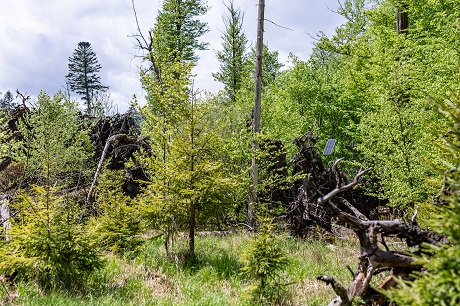
A small solar power plant hidden in the peat bog assists the researchers in their fieldwork in the forest.
During the dark years of communism, the area belonged to a high-security zone where only those who were strictly vetted could enter. The Communist regime was more interested in protecting totalitarian ideology than in protecting nature. The necessary care came only with the new era of democracy and freedom. The Žofín Forest was enclosed by a four-and-a-half-kilometre-long and two-metre-high chain-link fence (a new one is currently being constructed) to protect its young saplings from wildlife and against unwanted visitors. Entry to the forest, in fact, is forbidden. Only researchers with a permit are allowed inside, and visits like ours are only allowed with a guide.
Old-growth forests versus commercial forests
Lenka Michalčíková from the Institute of Microbiology of the CAS is making her way through the undergrowth on her way to the research site. A hiking backpack on her back, she nimbly steps over fallen trees densely covered in moss, of which nearly 200 species grow in the forest. In some places, there are several trunks haphazardly leaning on each other, and caution is advised – it rained recently, and the ground can get quite slippery here. With phone in hand (the mobile network coverage only works in a few spots in the forest), the researcher uses GPS to locate and track the research site where her institute is monitoring biological carbon fixation. Beeches as old as 400 years proudly tower skyward and can be found in the company of fir and spruce trees, and rarely the sycamore (maple), the Norway maple, and the wych elm. Blackbirds, robins, and finches provide nature’s soundtrack, and we’d find the highly endangered Eurasian three-toed woodpecker and the endangered hazel grouse nesting somewhere up in the canopy.
All around us are branches stuck in the ground and rotting wood. Trees don’t have regular spacing here like we’re used to in a regular forest. They just grow wherever there happened to be space and room in the sun. The forest is littered with uprooted trees and unnaturally positioned rocks. The windthrow repositioned them in a way that they now look like menhirs. Expect no paved roads, beaten paths, or hiking trail signs here. Here, it’s easy to get lost in the woods.
We’ve reached our destination. Lenka Michalčíková pulls her laptop out of the backpack and begins her work. A 30-centimetre white flow chamber, set within the soil, measures the amount of carbon dioxide released from the forest floor every 20 seconds. “Rich ecological communities of microorganisms can be found here that decompose the organic matter that produces carbon dioxide, and we use the chamber to detect the rate of decomposition,” Lenka Michalčíková explains as she attempts to download the measured data. She comes to this research site every six months or so to obtain new data. But today, it’s not going so well. She will have to take the equipment to the lab to find out why it malfunctioned.
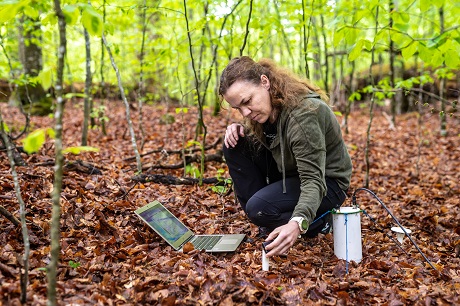
Lenka Michalčíková from the Institute of Microbiology of the CAS.
Not far from the chamber is a battery, a solar power charger, and a cable leading to the photovoltaic panels that the researchers have placed in the peat bog in the heart of the forest. There are also sensors – so-called lollipops – with dozens of them scattered across the forest. Their function is to measure the microclimate; temperature and humidity, two important parameters that affect the life of the microbial community. “The temperature is 16.5 degrees Celsius aboveground, 12.1 degrees Celsius at the surface level of the forest floor, and 9.8 degrees Celsius in the soil itself,” Michalčíková explains, showing the freshly captured data.
Monitored microorganisms
The current research Michalčíková is working on is led by Petr Baldrian from the Institute of Microbiology of the CAS. The research of rotting dead wood is what brought him to the Žofín Forest eight years ago. It is the abundance of windfallen trees that distinguishes the old-growth forest from the commercial forest, which people exploit economically. “The dead wood provides nutrients to the soil, where they are then better recycled. We were interested in which type of microorganisms are present in it and what characteristics they have,” Petr Baldrian explains.
The research kick-started his further scientific work in the Žofín Forest, supported by the Strategy AV21 Research Programme Land Conservation and Restoration. He and his team are currently seeking answers to questions regarding how old-growth forests differ from commercial forests, whether the diversity of the old-growth forest ecosystem is reflected in the diversity of microorganisms, and whether they allow for greater stability of the system as a whole.
“If a commercial forest grows naturally, it probably doesn’t mind that there are fewer species of fungi growing in it or fewer species of bacteria in the soil. But when some kind of disturbance occurs, such as a prolonged drought or insect invasion, it is much more susceptible to change, unlike a natural forest,” Baldrian says.
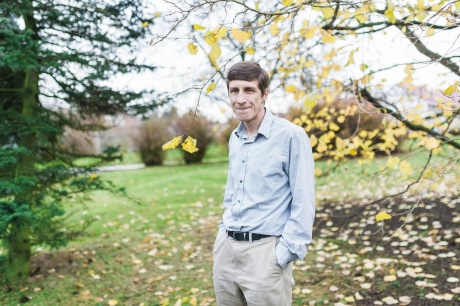
Petr Baldrian from the Institute of Microbiology of the CAS.
It is thanks to uneven-aged trees that the old-growth forest ecosystem does not cease to function; it never loses its tree level completely. “We believe that microorganisms, among other things, contribute to this by keeping the system running better,” Baldrian adds. His team is comparing six old-growth forests in the Czech Republic – in addition to Žofín Forest, these also include Boubín Primeval Forest in Šumava, Salajka Forest in the Beskid Mountains, and Býčí skála in the Moravian Karst – to six commercial forests.
The researchers would like to use their findings to put together guidelines on how to manage the forests properly; how much dead wood to leave in them, for instance, so that they won’t lose their economic function, but at the same time will be more stable and capable of coping with climate change threats. Researchers such as Přemysl Bobek, Petr Baldrian, and Lenka Michalčíková are bringing new insights into the richness of natural forest life and new ways to manage forests sustainably in the future.
The story can be found in the current Czech issue of the CAS A / Věda a výzkum magazine.
Prepared by: Zuzana Šprinclová, Division of External Relations, CAO of the CAS
Translated by: Tereza Novická, Division of External Relations, CAO of the CAS
Photo: Jana Plavec, Division of External Relations, CAO of the CAS
 The text and photos are released for use under the Creative Commons license.
The text and photos are released for use under the Creative Commons license.
Read also
- A trapped state: The pandemic impact on public attitudes, trust, and behavior
- Aerial archaeology: Tracing the footsteps of our ancestors from the sky
- Archaeologists uncover ancient finds along Prague Ring Road
- Our microbiome largely depends on what we eat, says microbiologist Michal Kraus
- The ABCs of writing: Why did its invention mark a turning point for humankind?
- We learn, remember, forget… What can memory actually do? And can we outsmart it?
- New Center for Electron Microscopy in Brno opens its doors to global science
- The hidden lives of waste: What can we learn from waste workers and pickers?
- A unique lab is hidden right beneath Prague’s Vítkov Hill
- Renewables are a strategic investment in European security, scientists say
The Czech Academy of Sciences (the CAS)
The mission of the CAS
The primary mission of the CAS is to conduct research in a broad spectrum of natural, technical and social sciences as well as humanities. This research aims to advance progress of scientific knowledge at the international level, considering, however, the specific needs of the Czech society and the national culture.
President of the CAS
Prof. Eva Zažímalová has started her second term of office in May 2021. She is a respected scientist, and a Professor of Plant Anatomy and Physiology.
She is also a part of GCSA of the EU.